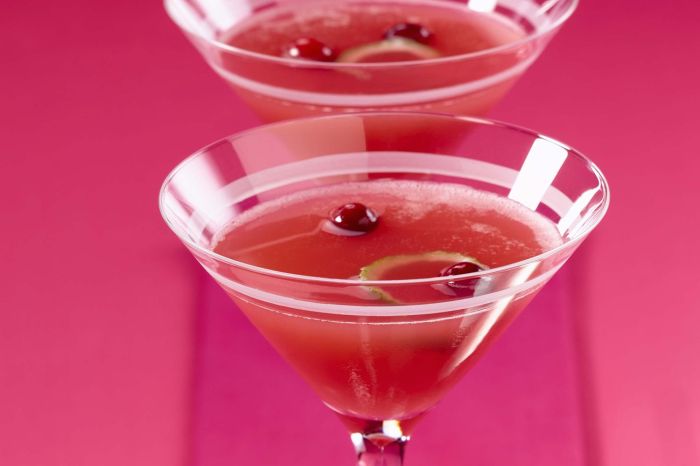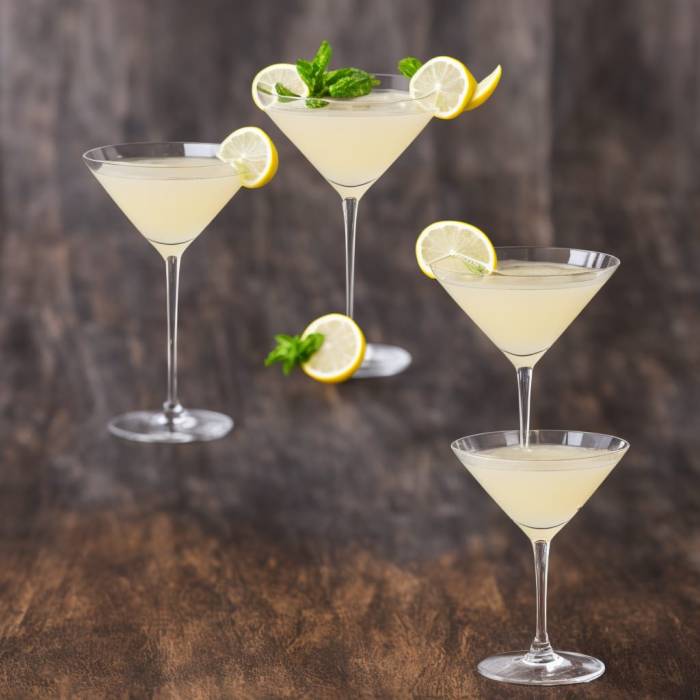The Gin Martini recipe is a timeless classic, embodying sophistication and elegance in every sip. This iconic cocktail has a rich history, dating back to the late 19th century, and has evolved over time to become a beloved staple in bars and homes worldwide.
Its simplicity belies its complexity, with the perfect balance of gin and dry vermouth creating a truly unforgettable taste.
From the classic recipe to its many variations, the Gin Martini offers a world of flavor exploration. Whether you prefer a traditional dry Martini or a bolder, more contemporary twist, there’s a Gin Martini out there for every palate.
This guide will delve into the history, ingredients, and techniques behind this iconic cocktail, empowering you to create your own perfect Gin Martini at home.
The Gin Martini

The Gin Martini is a classic cocktail that has been enjoyed for over a century. It is known for its simplicity, elegance, and versatility, making it a favorite among both novice and experienced cocktail enthusiasts.
History and Origin
The Gin Martini’s origins are shrouded in some mystery, but it is widely believed to have emerged in the late 19th century or early 20th century. Some historians attribute its creation to a bartender named John D. Martini at the Knickerbocker Hotel in New York City, while others point to its popularity in the early 20th century in London, where it was a favored drink among the city’s elite.
The Martini’s popularity grew rapidly during the Prohibition era in the United States, as it could be easily made with readily available ingredients.
Key Ingredients
The classic Gin Martini is a simple cocktail consisting of only two primary ingredients:
- Gin: The base spirit of the Martini, providing its characteristic juniper flavor.
- Dry Vermouth: A fortified wine that adds complexity and balance to the cocktail.
Variations and Adaptations
The Gin Martini is known for its versatility and has been adapted in countless ways over the years. Some popular variations include:
- The Dirty Martini: A classic Martini with a splash of olive brine added for a salty, savory flavor.
- The Gibson: A Martini garnished with a cocktail onion instead of an olive.
- The Perfect Martini: A Martini made with equal parts dry and sweet vermouth.
- The Vesper: A variation created by Ian Fleming for his fictional character James Bond, featuring gin, vodka, and Lillet Blanc.
Classic Gin Martini Recipe
The classic Gin Martini is a timeless cocktail that embodies elegance and simplicity. It’s a perfect balance of gin’s botanical flavors and vermouth’s dryness, creating a sophisticated and refreshing experience.
Ingredients and Ratio
The classic Gin Martini is a simple cocktail with only two main ingredients: gin and dry vermouth. The ratio of gin to vermouth is crucial in achieving the desired balance of flavors. While the traditional ratio is 6:1 gin to vermouth, many variations exist.
Using High-Quality Gin and Dry Vermouth, Gin martini recipe
The quality of the gin and dry vermouth used significantly impacts the taste of the Martini.
- Gin:Choose a high-quality gin with a robust juniper flavor and a balanced profile of botanicals. Popular options include Tanqueray, Bombay Sapphire, and Beefeater.
- Dry Vermouth:Dry vermouth adds complexity and a hint of bitterness to the Martini. Opt for a quality dry vermouth, such as Noilly Prat or Dolin.
Chilling and Stirring
Chilling the ingredients is essential for a refreshing and well-balanced Martini.
- Chill the Gin and Vermouth:Chill both the gin and dry vermouth in the refrigerator for at least 30 minutes before mixing. This ensures the drink is served ice-cold.
- Stir, Don’t Shake:Stirring the ingredients gently with ice is the preferred method for a classic Martini. This allows for a smooth, well-integrated cocktail without diluting it excessively.
Steps to Make a Classic Gin Martini
- Chill the Glass:Chill a martini glass in the freezer for 15-20 minutes.
- Prepare the Ingredients:Chill the gin and dry vermouth in the refrigerator for at least 30 minutes.
- Measure the Ingredients:Pour 2 ounces of chilled gin into a mixing glass filled with ice. Add 1/3 ounce of chilled dry vermouth.
- Stir Gently:Stir the ingredients with a bar spoon for 30-45 seconds, or until well-chilled.
- Strain and Serve:Strain the mixture into the chilled martini glass.
- Garnish:Garnish with a lemon twist or an olive.
Gin Martini Variations

The Gin Martini, a classic cocktail, offers a canvas for endless creativity. While the classic recipe is revered, numerous variations have emerged over time, each with its unique flavor profile and historical significance. These variations cater to diverse palates, showcasing the versatility of the Gin Martini and its enduring appeal.
Gin Martini Variations and Their Key Ingredients
Different variations of the Gin Martini are distinguished by the type of gin, vermouth, and additional ingredients used. Here is a table showcasing some popular variations and their key components:
| Variation Name | Gin | Vermouth | Additional Ingredients |
|---|---|---|---|
| Classic Gin Martini | London Dry Gin | Dry Vermouth | None |
| Dirty Martini | London Dry Gin | Dry Vermouth | Olive brine |
| Gibson | London Dry Gin | Dry Vermouth | Cocktail onion |
| Vodka Martini | Vodka | Dry Vermouth | None |
| Martini Royale | Gin | Dry Vermouth | Champagne |
Flavor Profiles of Gin Martini Variations
The flavor profiles of Gin Martini variations are influenced by the type of gin, vermouth, and additional ingredients used. * Classic Gin Martini:The classic Gin Martini features a crisp, dry, and botanical-forward flavor profile. The London Dry Gin provides juniper berries, citrus, and spice notes, while the dry vermouth adds a subtle bitterness and complexity.* Dirty Martini:The Dirty Martini introduces a savory and salty element through the olive brine.
The olive brine adds a distinct umami flavor, balancing the dryness of the gin and vermouth.* Gibson:The Gibson features a similar flavor profile to the Classic Gin Martini but with a slightly sharper, more pronounced onion flavor. The cocktail onion adds a distinct savory and pungent note, contrasting with the botanical flavors of the gin.* Vodka Martini:The Vodka Martini offers a clean, crisp, and neutral flavor profile.
The vodka provides a smooth and unflavored base, allowing the dry vermouth to shine through with its subtle bitterness and complexity.* Martini Royale:The Martini Royale combines the classic Gin Martini with the effervescence of champagne. This variation offers a refreshing and celebratory twist, blending the dryness of the gin and vermouth with the bubbly notes of champagne.
Historical Significance of Gin Martini Variations
Each Gin Martini variation has its own historical significance, reflecting evolving tastes and preferences.* Classic Gin Martini:The Classic Gin Martini is considered the original and most traditional form of the cocktail. Its origins can be traced back to the late 19th century, when gin was a popular spirit in England.* Dirty Martini:The Dirty Martini emerged in the early 20th century, likely as a result of bartenders experimenting with different flavors.
The addition of olive brine was a novel approach, adding a savory and salty element to the classic Martini.* Gibson:The Gibson was named after Charles Dana Gibson, a renowned American illustrator. The cocktail onion was introduced as a garnish in the early 20th century, replacing the olive.* Vodka Martini:The Vodka Martini gained popularity in the mid-20th century, coinciding with the rise of vodka as a popular spirit.
Its clean and neutral flavor profile appealed to those seeking a less botanical-forward Martini.* Martini Royale:The Martini Royale is a relatively recent variation, likely developed in the late 20th or early 21st century. It combines the classic Martini with the celebratory spirit of champagne, offering a refreshing and sophisticated twist.
Garnishing the Gin Martini

A garnish, in the context of a Gin Martini, is more than just a decorative element. It plays a crucial role in enhancing the overall experience by adding visual appeal, olfactory notes, and a final touch of flavor.
Further details about tips memompa asi agar melimpah is accessible to provide you additional insights.
Traditional Garnishes
The traditional garnishes for a Gin Martini are the olive and the lemon twist. These garnishes are chosen for their complementary flavors and textures that enhance the gin’s botanicals.
- Olive: The salty brine of the olive complements the dry, botanical notes of gin, creating a harmonious balance.
- Lemon Twist: The citrus zest of the lemon twist adds a bright and refreshing element, cutting through the gin’s dryness and enhancing its juniper notes.
Gin Martini Garnish Visuals
Visual representation of various Gin Martini garnishes can be described in detail. For instance, a classic olive garnish would feature a single green olive, usually pitted, resting on the rim of the chilled martini glass. A lemon twist garnish, on the other hand, would showcase a thin strip of lemon peel, carefully twisted to release its oils and aromas, adorning the edge of the glass.
Garnish Selection and Preparation
Choosing the right garnish for a Gin Martini depends on personal preference and the specific gin used. For a classic Martini, a green olive or a lemon twist is the standard choice. However, variations exist, with some preferring olives stuffed with blue cheese, pickled onions, or even a sprig of rosemary.
- Olive: Select firm, plump olives with a vibrant green color. Avoid olives that are mushy or discolored.
- Lemon Twist: Use a fresh lemon with a bright yellow peel. Cut a thin strip of peel, avoiding the white pith, as it can be bitter. Twist the peel over the drink to release its oils before gently placing it on the rim of the glass.
Serving and Enjoying the Gin Martini

The final step in crafting the perfect Gin Martini is serving and enjoying it. Choosing the right glassware, ensuring the ideal temperature, and presenting it beautifully all contribute to an unforgettable experience.
Glassware
The traditional choice for serving a Gin Martini is a chilled Martini glass. Its iconic cone shape with a wide bowl and a narrow stem allows for a proper swirl and enhances the aroma. The chilled glass helps maintain the drink’s coolness, ensuring a refreshing and flavorful experience.
Temperature
A Gin Martini is best served chilled, ideally between 32°F to 40°F (0°C to 4°C). This temperature allows the flavors of the gin and vermouth to come together harmoniously, while also maintaining the drink’s crispness. To achieve this temperature, chill the Martini glass in the freezer for at least 30 minutes before serving.
Presentation
A visually appealing presentation adds an extra layer of elegance to the Gin Martini. Here are some tips for creating a beautiful display:
- Garnish: A simple yet effective garnish enhances the drink’s aesthetics. A lemon twist, olive, or cocktail onion are classic choices. The garnish should be fresh and vibrant, adding a pop of color and fragrance to the drink.
- Ice: The ice used in the drink should be clear and large, adding to the visual appeal. Avoid using crushed ice, as it can dilute the drink too quickly.
- Lighting: The lighting used to showcase the Gin Martini plays a crucial role. Soft, warm lighting creates a sophisticated ambiance, highlighting the drink’s color and clarity.
Food Pairings
The Gin Martini’s dry and refreshing character makes it an excellent companion for various food pairings. Here are some recommendations:
- Seafood: The Gin Martini’s botanical notes complement the delicate flavors of seafood, such as oysters, shrimp, and salmon.
- Cheese: A sharp cheddar or a creamy brie pairs well with the dryness of the Gin Martini, creating a harmonious balance of flavors.
- Salads: A light and refreshing salad with a vinaigrette dressing provides a delightful contrast to the boldness of the Gin Martini.
Concluding Remarks: Gin Martini Recipe

The Gin Martini, a timeless classic, remains a testament to the enduring allure of simplicity and sophistication. With its diverse variations and endless possibilities for personalization, the Gin Martini continues to captivate and inspire cocktail enthusiasts. Whether you’re a seasoned bartender or a novice mixologist, exploring the world of Gin Martinis is an exciting journey of flavor and creativity.
